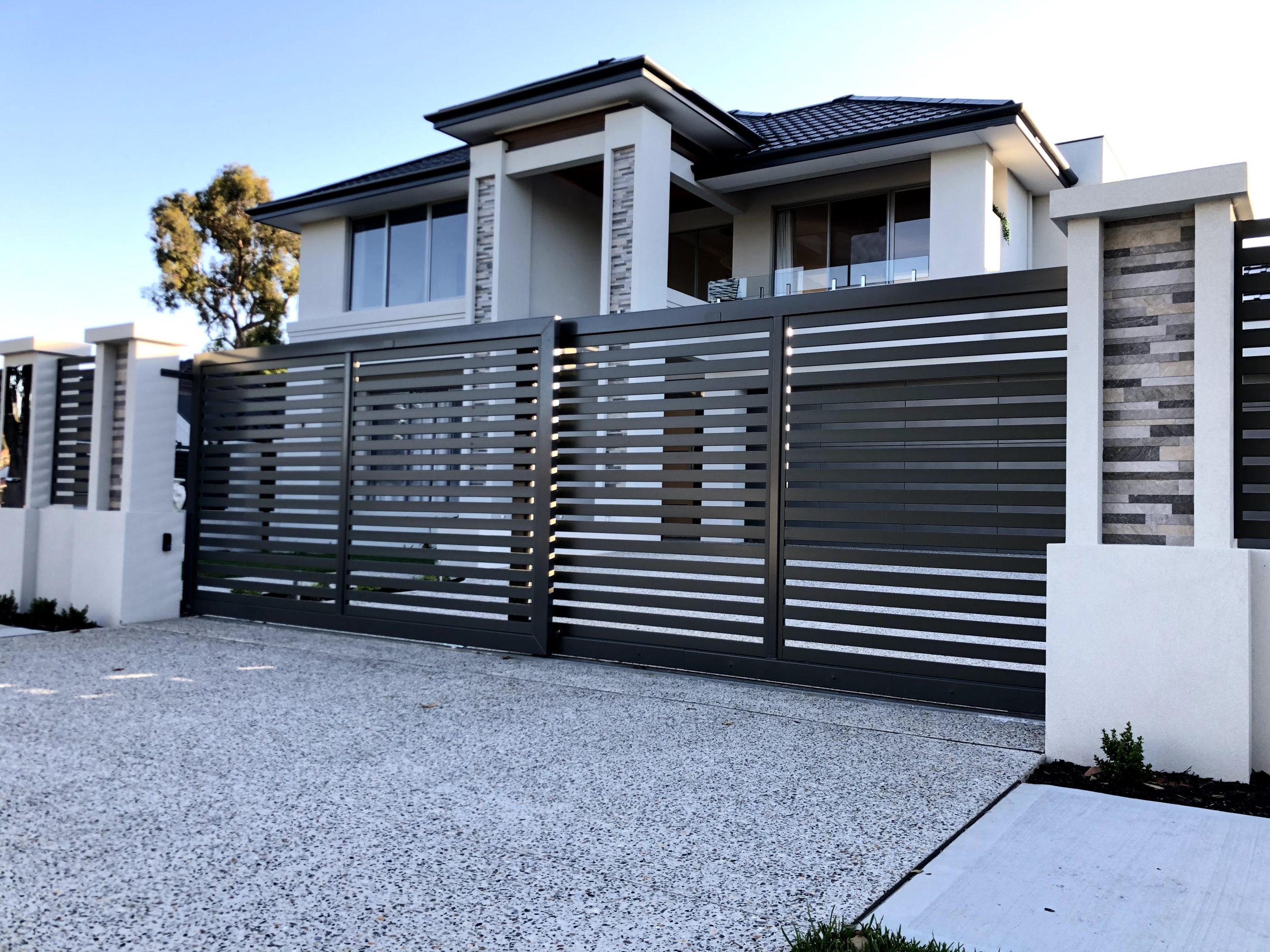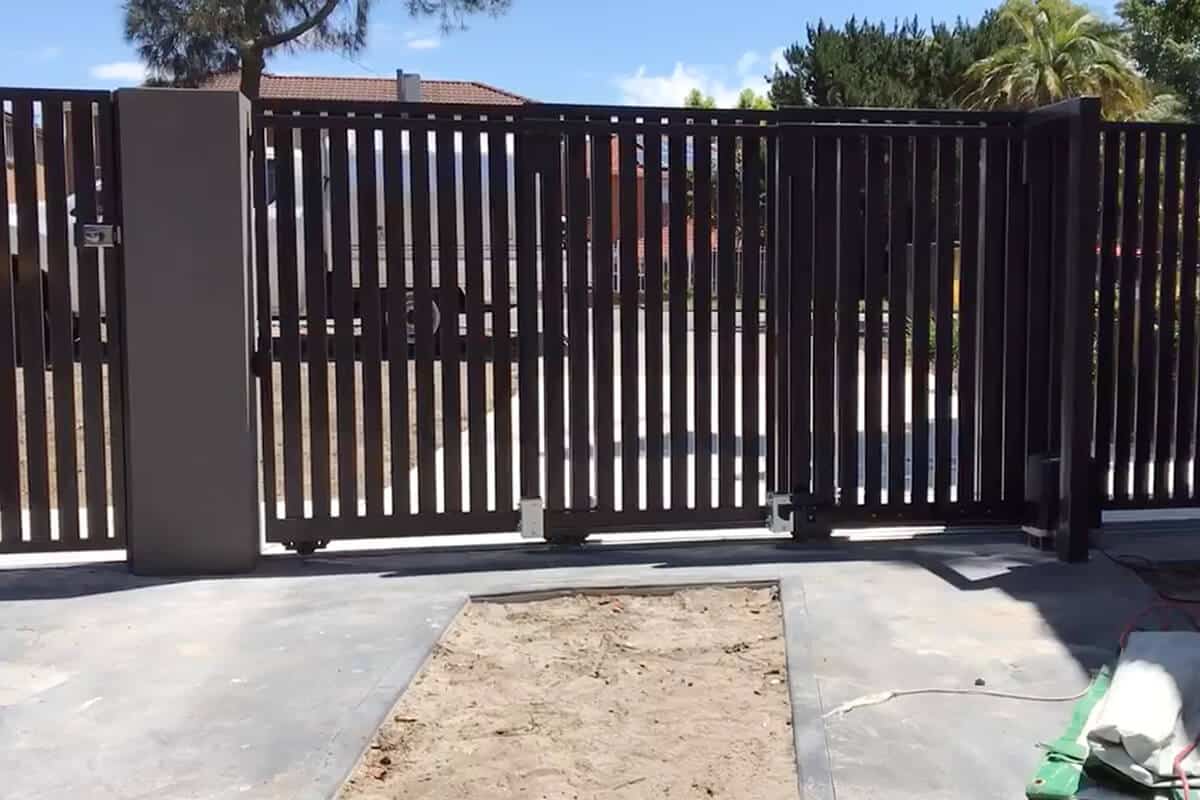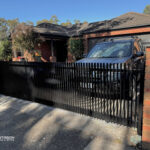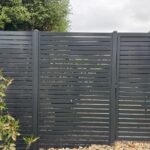
If you are looking for an automatic gate that perfectly balances modern beauty, style, and excellent privacy and security enhancement, Telescopic Sliding Gates are a suitable choice for you. With a unique design that saves space when opening the gate compared to other automatic gates, these gates have become very popular in recent years.
Telescopic Sliding Gates offer homeowners and property owners many benefits, such as enhancing the aesthetics of the house, increasing privacy, and ensuring safety. Installing a Telescopic Sliding Gate also depends on various factors such as materials, colors, and styles. These elements make your gate more unique, innovative, and attractive while still ensuring its functions.
What is a Telescopic Sliding Gate?
A Telescopic Sliding Gate is an innovative type of automatic gate designed to offer enhanced security, privacy, and aesthetic appeal while maximizing space efficiency. Unlike traditional sliding gates, which require a large area to open fully, telescopic sliding gates consist of multiple panels that slide together in a telescoping fashion. This unique mechanism allows the gate to retract into itself, significantly reducing the space needed for operation. Ideal for properties with limited space, these gates provide a sleek and modern look, adding a touch of sophistication to any residential or commercial property.
Telescopic Sliding Gates come with a range of features that make them highly desirable. They are constructed from durable materials such as steel or aluminum, ensuring robust security and longevity. The gates often include advanced locking systems and automation features, allowing for convenient and secure operation via remote controls, keypads, or smartphone apps. Customizable in terms of materials, colors, and designs, telescopic sliding gates can be tailored to match various architectural styles, enhancing the overall aesthetic of the property. Their combination of functionality and modern design makes them a popular choice for those seeking both style and security.
Types of Telescopic Sliding Gates

1. Single Telescopic Sliding Gate
- Description: A single telescopic sliding gate consists of one primary gate leaf that telescopes out to one side. The gate is designed with multiple panels that slide and stack along a single track or rail. When the gate opens, the panels fold and slide behind each other, reducing the gate’s overall space requirements. This type of gate is often supported by a rolling or wheeled mechanism that runs smoothly along the track.
- Use Case: Single telescopic sliding gates are particularly suitable for residential properties or commercial spaces with moderate space constraints. They are ideal for narrow driveways, small parking lots, or entrances where a full-width gate is needed but space for the gate’s movement is limited. These gates offer a space-efficient solution while providing security and convenience for daily use.
2. Double Telescopic Sliding Gate
- Description: A double telescopic sliding gate features two main gate leaves that telescope out in opposite directions. Each leaf operates independently but aligns perfectly to create a full-width opening. The panels slide and stack in two directions, often utilizing multiple tracks to ensure smooth operation. This design allows for a more expansive gate opening, suitable for larger entrances.
- Use Case: Double telescopic sliding gates are ideal for wider openings, such as driveways, large entrances, or industrial facilities. They are well-suited for properties with higher traffic or where a larger clearance is required for vehicles or equipment. The dual-leaf design maximizes the opening width while maintaining a compact footprint when the gate is in the open position. This type of gate is advantageous for spaces that need to accommodate larger vehicles or provide easy access while still benefiting from space-saving features.
Benefits of Telescopic Sliding Gates

Space Efficiency
One of the standout features of telescopic sliding gates is their remarkable space efficiency. Unlike traditional swinging gates that require a substantial amount of clearance to open, these gates operate by sliding horizontally along the fence line or wall, making them an ideal solution for properties with limited space. This innovative design allows the gate to retract into itself, effectively minimizing the space needed for the gate to function.
The space-saving nature of telescopic sliding gates is particularly beneficial for urban environments or properties with narrow driveways where maximizing usable space is essential. By sliding parallel to the perimeter, these gates free up valuable space that can be used for parking or landscaping, ensuring that the entrance area remains uncluttered and functional.
Automation
Automation is a key advantage of telescopic sliding gates, offering a blend of convenience, security, and modern technology. These gates can be seamlessly integrated with automated systems, allowing for effortless operation through remote controls, keypads, smartphones, or even voice-activated devices. This level of automation significantly enhances user convenience, enabling gate operation without the need to manually open or close it, which is especially beneficial during adverse weather conditions or for individuals with mobility issues.
Improved Security and Privacy
Telescopic sliding gates are renowned for their enhanced security and privacy features, making them an excellent choice for residential, commercial, and industrial properties. These gates provide a robust barrier that deters unauthorized access and protects the property from intruders. The solid construction and overlapping panels of these gates create a formidable defense, ensuring that the perimeter is well-secured.
They can be connected to surveillance cameras, motion detectors, and alarm systems, providing comprehensive protection. This integration allows property owners to monitor activity around the gate and receive alerts in case of suspicious movements, enhancing overall security. Additionally, by blocking the view, telescopic sliding gates create a secluded environment where residents can enjoy their outdoor spaces without concerns about prying eyes.
Aesthetic
Telescopic sliding gates offer a remarkable blend of functionality and aesthetic appeal, making them a popular choice for both residential and commercial properties. Their sleek, modern design can significantly enhance the visual appeal of any property, creating a lasting impression of elegance and sophistication.
These gates are highly customizable, allowing property owners to choose from a variety of materials, finishes, and colors to match their specific tastes and the existing aesthetic of their property. Whether constructed from steel, aluminum, or even wood, these gates can be tailored to fit perfectly with the desired look.
Materials of Telescopic Sliding Gates
Telescopic Sliding Gates come in a variety of materials, each with its own characteristics, advantages, and disadvantages. Understanding these materials will help homeowners and property owners make informed decisions..
1. Wrought Iron Telescopic Sliding Gates

Wrought iron telescopic sliding gates are renowned for their strength and durability, making them a popular choice for those seeking both security and elegance. The robust nature of wrought iron ensures that the gates can withstand significant force and adverse weather conditions, offering long-term protection for properties.
One of the primary advantages of wrought iron is its low maintenance requirement. When properly treated with a protective coating, wrought iron gates resist rust and corrosion, maintaining their appearance and functionality over time with minimal upkeep. Despite the initial higher cost compared to other materials, the durability, security, and aesthetic versatility of wrought iron telescopic sliding gates make them a worthwhile investment for enhancing the value and appeal of a property.
2. Steel Telescopic Sliding Gates

Steel telescopic sliding gates are a popular choice for property owners seeking a blend of durability, security, and modern design. Known for its exceptional strength, steel provides a sturdy and reliable barrier, ideal for high-traffic areas and properties that require enhanced security. These gates are designed to withstand the test of time, resisting damage from weather conditions and daily use.
With protective coatings such as powder coating, steel gates are highly resistant to rust and corrosion. This ensures that they maintain their functionality and appearance over the years with minimal upkeep.
3. Timber Telescopic Sliding Gates

Timber telescopic sliding gates offer a unique blend of natural beauty and functionality, making them a popular choice for homeowners seeking an elegant and timeless addition to their property. These gates are crafted from high-quality wood, such as cedar, redwood, or teak, known for their durability and resistance to decay. The natural grains and textures of wood provide a warm, welcoming aesthetic that complements a variety of architectural styles, from traditional to modern.
Telescopic sliding gates can be made from a variety of materials, each offering different benefits in terms of durability, aesthetics, and functionality. Here are some common materials used for telescopic sliding gates:
4. Aluminum telescopic sliding gates

- Description: Aluminum telescopic sliding gates are lighter than steel and naturally resistant to rust and corrosion. They can be finished with powder coating or anodizing for additional protection and aesthetic appeal.
- Advantages: Lightweight, resistant to rust, and available in a range of colors and finishes. Aluminum gates are also relatively low-maintenance.
- Use Case: Suitable for residential applications and commercial properties where a lightweight gate is beneficial, and where maintenance and appearance are important.
How Does a Telescopic Gate Work?
Each material offers distinct advantages depending on the specific requirements of the installation site, such as climate, security needs, aesthetic preferences, and budget.
A telescopic gate operates by sliding open and closed through a system of overlapping gate panels. Here’s a breakdown of how it works:
- Panel Structure: The gate consists of multiple panels that are designed to slide and stack upon each other. These panels are connected in such a way that they fold and unfold as the gate moves.
- Sliding Mechanism: The gate slides on tracks or rails that are installed along the gate’s opening. The panels are mounted on rollers or wheels that run along these tracks, allowing the gate to slide smoothly.
- Overlapping Panels: When the gate opens, the panels slide and stack neatly on one side of the gate opening. Each panel overlaps the one before it, reducing the amount of space needed for the gate to open compared to a traditional sliding gate.
- Actuation: Telescopic gates can be manually operated or automated. For automated gates, an electric motor or actuator drives the gate’s movement. Sensors and control systems can be integrated to open or close the gate automatically based on commands or detected presence.
- Space Efficiency: The design of telescopic gates makes them ideal for locations with limited space where a traditional swing or sliding gate might be impractical. The compact stacking of panels allows the gate to open without needing extra space for the gate’s movement.
Overall, the telescopic gate’s efficient design allows it to be used in various applications where space and operational convenience are important factors.




